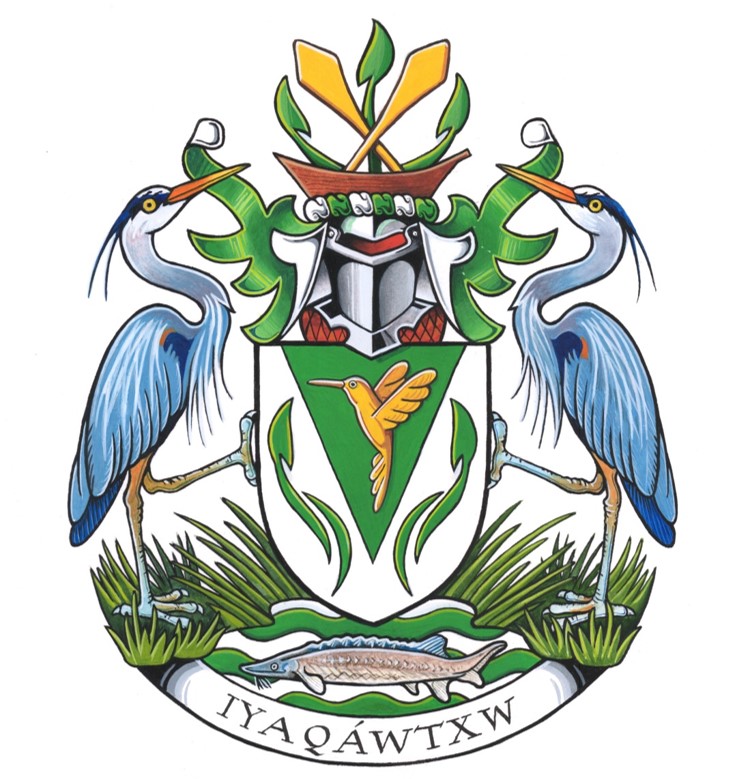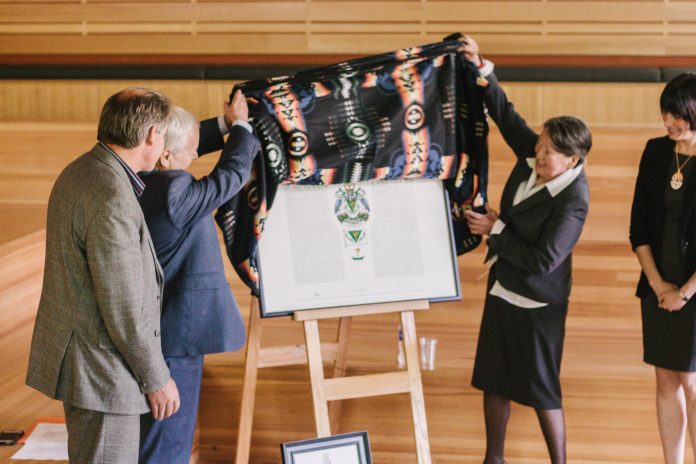The proclamation of the grant of heraldic emblems to the University of the Fraser Valley was made last week. UFV received its official institutional coat of arms; the unveiling took place on Monday June 5, and was accompanied by a presentation from a herald on behalf of the office of the Chief Herald of Canada.
A coat of arms is a uniquely designed set of symbols that represents an institution, country, or individual. The tradition comes from the Middle Ages, when individuals would wear their arms on battle regalia. It is both a legal and symbolic representation for the bearer and follows a specific set of design rules: among other elements, there will be a shield, crest, and motto.
What’s especially unique about UFV’s coat of arms is the use of Halq’emeylem for the saying, rather than Latin or English. This coat of arms strongly builds from the heritage and culture of local First Nations.
The saying, Iyaqáwtxw, means “house of transformation.”

‘Coat of arms symbolism’
At the unveiling, UFV Chancellor Gwen Point explained the significance of each symbol.
Sturgeon, seen at the bottom of the arms, is one of the oldest beings that lives in the Fraser Valley. It can survive under the harshest conditions. Point said that like all animals and birds, the Stó:l? use every part of the sturgeon — bones for needles, oil for medicine and lamps, and the meat for a community feast.
Marshes and waterways are essential to the Fraser Valley. The marsh symbol refers to the rich land and the lifeline to this place. “The area is teeming with life and vitality, the water and the wetlands are a source of life. In a similar way, the university is a source of knowledge,” Point said.
The two blue herons, or the “supporters,” uniquely hold the shield up with their second leg. Typically, the animal is stylized to use their forelegs to support the shield. Blue herons are often seen flying over or near waterways in the Fraser Valley. To the Stó:l? hunters and fisherman, the heron says that they will have a good hunt or catch — they bring luck.
The hummingbird, seen in the middle, is a joyous creature. They are fragile, but Point said she likens it to true love, and students must love what they do.
“That’s what’s important, to find joy in what you’re doing in life, regardless of what you’re doing and where you are, you must find that,” said Point.
The canoe and paddle, at the top of the coat of arms, is a very important symbol to the Stó:l? people. And in this context, it represents the journey they’re on, and their connection to the university.
The vines on the sides are from the UFV logo. They also represent education as a form of nurturing, growth, and transformation.
“The new symbol blends some of our past, our connection with the land, the geography, and the mission of the university,” said Point.
‘Getting there’
The coat of arms is created and granted by the Canadian Heraldic Authority (CHA). The CHA was created in 1988, when Canada’s governor general received authority from Queen Elizabeth II to grant armorial bearings.
Prior to the creation of the CHA, Canadians wishing to have coat of arms granted had to apply through the College of Arms in London, or the Court of the Lord Lyon in Edinburgh.
The idea for UFV to receive a coat of arms came up not long after the institution attained university status.
In October 2008, the UFV board of governors requested the granting of official armorial bearings for the University of the Fraser Valley. But the project sat quietly until 2012 when university secretary, Al Wiseman, sent a formal request to the Canadian Heraldic Authority for a coat of arms. Wiseman has coordinated the project since.
There was a fair bit of back and forth discussion. It focused on the way the process works, what symbols are available and what they mean, and how it would piece together. Once a preliminary idea had been established, the herald sketched a series of coat of arms possibilities. That led to more discussion about key symbols and design. It was specifically requested that the saying would be written in Halq’emeylem.
“From the start there was a real interest on the herald’s end to include symbols that were particular to the Fraser Valley, to UFV, and also to reflect the Stó:l? culture and heritage,” Wiseman said. “So it was mostly those three things that were focused on.”
Point said, “When I thought about it, I thought, here’s an act of reconciliation.”
After the design was approved by the herald and institution, it was sent to an artist who would draft the design, then to a professional painter to paint. A calligraphist painted the motto, and hand-wrote the proclamation.
Commonly, coat of arms’ mottoes are written in Latin or English. Wiseman said that although the university believes Latin is important in the history of education, it doesn’t reflect UFV as a unique institution.
“We are situated on the traditional territory of the Stó:l? people, their generosity and their openness has made it possible for us to thrive here,” said Eric Davis, provost, vice-president academic. “We have built strong relationships with the Stó:l? community and it’s become a fundamental part of our DNA, to recognize that we have this relationship, we are on unceded territory, and we are a very community connected university.”
UFV had the idea of what the coat of arms should say in English, then consulted with Stó:l? Nation linguist and instructor at the University of British Columbia Dr. Strang Burton to come up with the best Halq’emeylem word.
“Transformation. We like that because it reflects the mandate of the university as a place of change,” said Point. “When we think of that, we think of intellectual and character transformation.”


